M
Leave a Legacy
of Giving
You can support our mission of changing lives by saving sight in multiple ways!
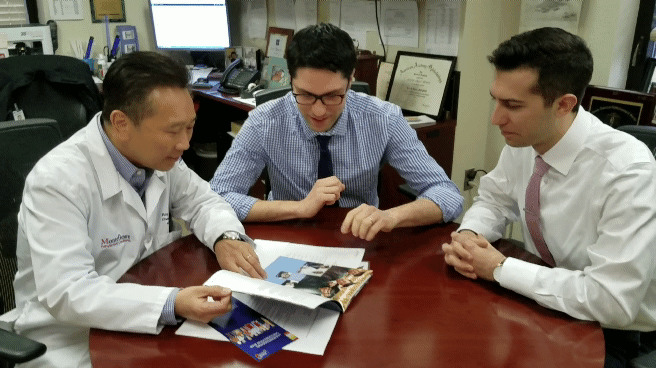
Saving Sight is honored to be co-authors with Montefiore Medical Center and Albert Einstein College of Medicine on two research presentations at the 2019 Annual Meeting of the Association for Research in Vision and Ophthalmology (ARVO). Collaborating with ophthalmology residents and leading researchers and surgeons helps drive vision-research forward. These projects highlight how much is gained in advancing research in corneal transplantation through collaborations with eye banks, medical centers and researchers. Working together allows us to honor the gift of sight and advance the treatment of corneal disease.

Dr. Roy Chuck, Dr. Gabriel Rand, and Dr. Dan Polla
“Some of our major presentations at the ARVO meeting this year are based on our partnership with the Saving Sight eye bank, who have been just a pleasure to work with,” said Dr. Roy Chuck, Chairman of Ophthalmology and Visual Sciences at the Albert Einstein College of Medicine and the Montefiore Medical Center. “They are very forward looking in the world of eye banking in that they have gone ahead and developed a very organized and large electronic database. In this age of research in our field of ophthalmology, and really in medicine in general, it’s all about big data.”
“We think of ourselves as forward-thinking and part of the forward-thinking is figuring out appropriate ways to work with our partners outside of the academic community, which includes eye banks and industry. What you’ll see in our research are very good collaborations that are appropriate and the right way to look forward as we develop science in this new era,” added Dr. Chuck.
Dr. Chuck is proud to work with his residents, Dr. Gabriel Rand and Dr. Dan Polla in their research endeavors. Drs. Polla and Rand are lead authors on the two research presentations that will be presented at ARVO 2019. Read why they value research collaborations:
“The collaboration between Saving Sight and Montefiore is very important and beneficial because we all ultimately have the same goal, which is to restore and improve sight in those in need. By collaborating, we are able to help each other be better in what we respectively do, ultimately leading to better outcomes on both fronts,” said Dan Polla, MD, Ophthalmology Resident at Montefiore Medical Center.
“Cornea and corneal transplants are such exciting field and I feel really lucky and grateful to be a part of it and to be doing research that makes an impact.”
“Working with Saving Sight has been an amazing opportunity for me. I’ve been working on research projects with them that involve looking at their large databases and trying to find factors that influence the quality of the corneal grafts that come out of the eye bank,” said Dr. Gabriel Rand, Second Year Ophthalmology Resident at Montefiore Medical Center. “This has been such an incredible opportunity because, not only as a resident do I get to experience taking care of patients in the clinic and operating room, but I can also participate in the science of advancing care for patients and helping to identify factors that contribute to better grafts and better patient outcomes.”
Saving Sight is a nonprofit eye bank with a mission to change lives by saving sight. Founded in 1960, Saving Sight has grown to become one of the nation’s leading eye banks and is focused on providing innovative solutions to its clinical and research partners. Saving Sight welcomes customized research collaborations that meet your research tissue needs and strives to advance the field of corneal transplantation through dynamic collaborations with medical centers and researchers. Headquartered in Kansas City, Mo., Saving Sight facilitates eye donation in Missouri, Kansas, and Illinois, serving transplantation and research specialists locally and around the world.
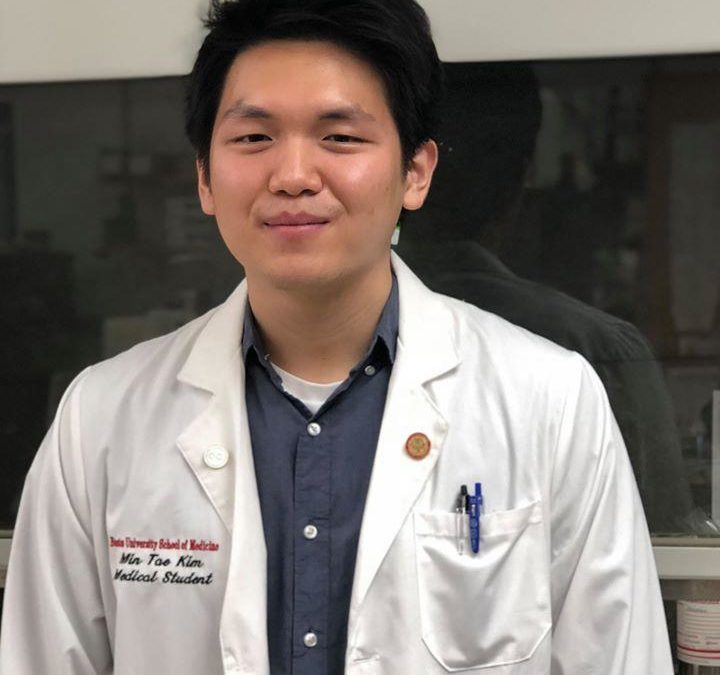
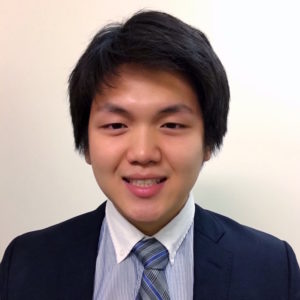
Min Tae Kim is the recipient of a Fight For Sight Summer Student Fellowship.
Kansas City, Mo. (July 5, 2018) – Nonprofit organizations Fight for Sight and Saving Sight have awarded a $2500 scholarship to Boston University School of Medicine student, Min Tae Kim, for his study of how type 2 diabetes effects corneal wound healing and repair. In his research, Kim will study the role of a channel protein, Pannexin-1, in both normal wound repair and that of diabetic tissue.
“With a better understanding of the wound healing process and its differences in diabetic and non-diabetic individuals, it may become possible for us to develop ways to better monitor these types of health complications and develop therapeutics targeting diabetic corneal dysfunction,” said Kim.
Kim was awarded the grant through Fight for Sight’s Summer Student Fellowship program, which provides support to undergraduate, graduate or medical students pursuing eye-related clinical or basic research. This particular scholarship was joint-funded by Kansas City area eye bank, Saving Sight.
“Saving Sight is proud to provide ongoing support to the ocular research community,” said Tony Bavuso, Chief Executive Officer at Saving Sight. “It’s exciting to contribute to the success of the next generation of ocular researchers in hopes of finding new treatments.”
About Saving Sight
Saving Sight is a 501(c)(3) nonprofit organization with a mission to change lives by saving sight. Founded in 1960, Saving Sight has grown to become one of the nation’s leading eye banks and is focused on providing innovative solutions to its clinical partners. Headquartered in Kansas City, Mo., Saving Sight facilitates eye donation in Missouri, Kansas, and Illinois, impacting the lives of those both near and far through transplantation.
About Fight for Sight
Since 1946, Fight for Sight (FFS) has supported and inspired eye and vision research by funding promising scientists early in their careers. FFS has granted over $21 million in research that has contributed directly or indirectly to major advances in ophthalmology and vision research, including the development of the IOL, aspects of donor cornea preservation, various use of ophthalmic lasers, glaucoma treatment and gene therapy.
###
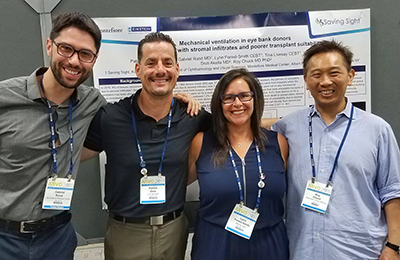
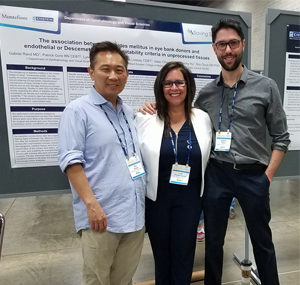
Dr. Roy Chuck, Lynn Forest-Smith and Dr. Gabriel Rand at ARVO 2018
With the rise in diabetes, discussion over the quality of corneal transplant tissue from diabetic donors in US eye banks is of concern. According to new research presented this week at the 2018 Annual Meeting of the Association for Research in Vision and Ophthalmology in Honolulu, scientists are one step closer to proving the suitability of the tissue from diabetic donors.
Through the study, a retrospective analysis was conducted to determine if corneas from diabetic donors were more likely to be marked unsuitable for surgical use based upon poor Descemet membrane (DM) or endothelial cell ratings.
This project, led by Gabriel Rand, MD, resident at the Albert Einstein College of Medicine Department of Ophthalmology and Visual Sciences, found that the presence of diabetes was not significantly associated with reduced transplant suitability. This study was the first in collaboration with Kansas City-based nonprofit Saving Sight’s donor data and is consistent with previous studies to support the continued preservation of the diabetic donor pool.
“Many cornea transplant surgeons are apprehensive about using grafts from diabetic donors because they believe the tissue to be of poorer quality. We analyzed the Saving Sight database and found that diabetes was not associated with differences in tissue quality across a number of eye bank suitability criteria. The research supports greater transplant utilization of tissue from diabetic donors,” said Dr. Rand.
Saving Sight Chief Business Development Officer Patrick Gore, RN, CEBT, Director of Business Development Lynn Forest-Smith, and Chief Operating Officer Tina Livesay were co-authors on the study. As an eye bank that facilitates eye donation for transplant and research, Gore said Saving Sight is proud to support this project and to work in collaboration with Montefiore and Drs. Rand, Chocron, Hu, Akella and Chuck.

Dr. Gabriel Rand, Patrick Gore, Lynn Forest-Smith and Dr. Roy Chuck at ARVO 2018
“We appreciate partnering with such dynamic collaborators to further ophthalmic research. To paraphrase the great Helen Keller, we believe that working together we can always achieve so much more,” said Gore.
In addition to the diabetes study, the team also presented their findings on mechanical ventilation in eye bank donors and its association with poorer corneal transplant suitability at ARVO 2018.
These studies continue to advance innovation and research in corneal transplantation through collaboration between eye banks, medical centers, and researchers.
“Eye banks have traditionally had the essential role of supplying donor tissues that enable people to see,” said Dr. Rand. “Working with Dr. Chuck and Saving Sight has been an incredible opportunity for me to understand how in addition to this role, eye banks can also advance academic research in the field of ophthalmology.”
Abstracts:
Diabetes mellitus in eye bank donors does not impact corneal transplant suitability
Authors: Gabriel Rand MD, Isaac Chocron MD, Jimmy Hu MD, Patrick Gore RN CEBT, Lynn Forest-Smith CEBT, Tina Livesay CEBT, Roy Chuck MD PhD
Mechanical ventilation in eye bank donors is associated with poorer corneal transplant suitability
Authors: Patrick Gore RN CEBT, Gabriel Rand MD, Isaac Chocron MD, Lynn Forest-Smith CEBT, Tina Livesay CEBT, Sruti Akella MD, Roy Chuck MD PhD

Kansas City, Mo. (January 8, 2018) – Today, non-profit organizations Saving Sight and Fight for Sight announced the joint funding of two new Summer Student Fellowships. The grants will be available to undergraduate, graduate or medical students conducting research relating to either the cornea or dry eye.
“Research and innovation within the field of ophthalmology are what drives our work forward as an eye bank,” said Tony Bavuso, CEO of Saving Sight. “We’re thrilled to partner with Fight for Sight to support students who are pursuing academic ocular research.”
The two grant awards will be $2,500 each with applications due to Fight for Sight on February 15, 2018. The announcement of awards is expected in May of 2018.
“We are thrilled to be partnering with Saving Sight on two new Summer Student Fellowships,” said Arthur Makar, Fight for Sight’s Executive Director. “Together we will fund the next generation of leaders in corneal and dry eye research.”

Saving Sight is a 501(c)(3) nonprofit organization with a mission to change lives by saving sight. Founded in 1960, Saving Sight has grown to become one of the nation’s leading eye banks and is focused on providing innovative solutions to its clinical partners. Headquartered in Kansas City, Mo., Saving Sight facilitates eye donation in Missouri, Kansas, and Illinois, impacting the lives of those both near and far through transplantation.
About Fight for Sight
Since 1946, Fight for Sight (FFS) has supported and inspired eye and vision research by funding promising scientists early in their careers. FFS has granted over $21 million in research that has contributed directly or indirectly to major advances in ophthalmology and vision research, including the development of the IOL, aspects of donor cornea preservation, various use of ophthalmic lasers, glaucoma treatment and gene therapy.
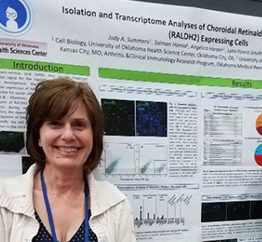
Kansas City, Mo. (May 11, 2017) – The millions projected to be diagnosed with myopia, or nearsightedness, in the coming years may soon have an option other than corrective eyewear or refractive surgery to restore their vision. According to new research presented this week at the Annual Meeting of the Association for Research in Vision and Ophthalmology (ARVO), scientists are one step closer to developing a molecular treatment that could slow development of the condition.

Myopia is the most common refractive error. The condition results when the eye is too long for the focusing power of the cornea and lens of the eye. High myopia can increase the risk of cataracts, glaucoma, retinal detachment and myopic macular degeneration.
“By 2050, high myopia will become the leading cause of blindness in many countries, affecting 1 billion people worldwide,” said Dr. Summers. “By finding a treatment to slow the development of myopia, we could prevent these blinding eye conditions, particularly in children who are most at risk.”
Saving Sight Director of Business Development Lynn Forest-Smith was a co-author on the project. As an eye bank that facilitates eye donation for transplant and research, Forest-Smith said Saving Sight was excited to support this important project with donated eye tissue.
“There may be no better way to honor the gift of our eye donors than through support of research like this which could help save the sight of nearly 5 billion people over the next few decades,” said Forest-Smith.
About Saving Sight
Saving Sight is a 501(c)(3) nonprofit organization with a mission to change lives by saving sight. Founded in 1960, Saving Sight has grown to become one of the nation’s leading eye banks and is focused on providing innovative solutions to its clinical partners. Headquartered in Kansas City, Mo., Saving Sight facilitates eye donation in Missouri, Kansas, and Illinois, impacting the lives of those both near and far through transplantation and eye research.
###
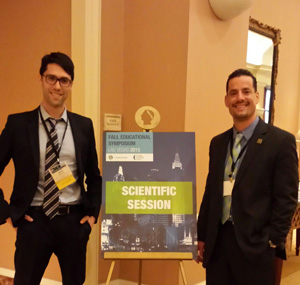

Gabriel Rand (left) and Patrick Gore (right) at the Cornea Society and Eye Bank Association of America’s Fall Educational Symposium.
New research could help Saving Sight and other eye banks more easily identify donated tissue which may be better suited for research than transplantation simply by examining donor medical records. A recent study of 12,703 cornea donors found use of certain topical glaucoma medications was associated with lower corneal endothelial cell density of donors. Cell density is an important factor in determining the best use of donated eye tissue.
By using this information to evaluate potential eye donor cases, Saving Sight and other eye banks could focus on recovering tissue for transplant which provide the best chance for successful transplants. Other tissue could be recovered specifically for research purposes to help save sight through advances in medical practice.
Saving Sight Senior Director of Business Development Patrick Gore, RN contributed to the research as a co-author. Gore said this research is exciting because it demonstrates how eye banks can leverage data to make decisions.
“This is the tip of the iceberg in terms of how eye banks can leverage donor information to make data-driven decisions and be the best stewards possible of the precious gift of sight donors give through eye and tissue donation,” Gore said.
The findings were presented at the Cornea Society and Eye Bank Association of America’s Fall Educational Symposium in Las Vegas, Nevada on November 13, 2015 by Gabriel Rand, MA. In addition to Gore and Rand, tthe study was also coauthored by Ji Won Kwon, MD, PhD; Kyong Jin Cho, MD, PhD; Mitchell D. McCartney, PhD; and Roy S. Chuck, MD, PhD.